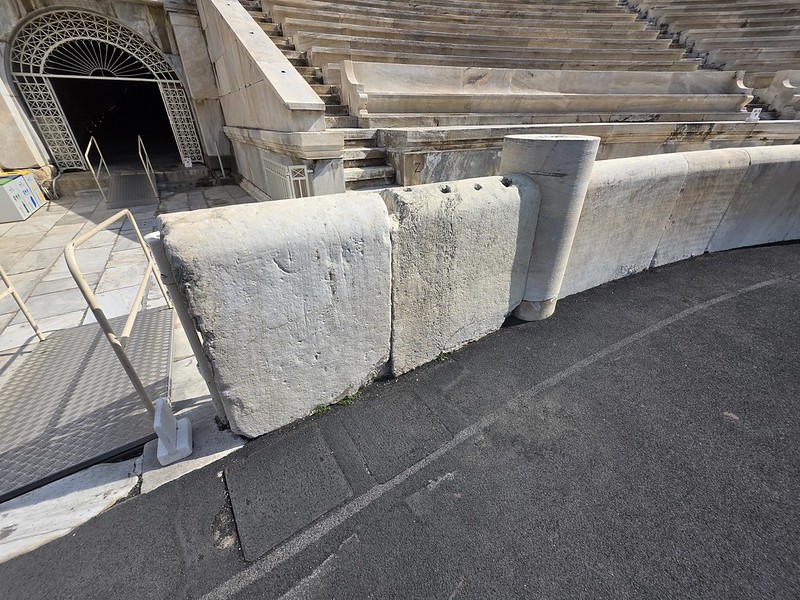Athens – Panathenaic Stadium (Part 1 – The Ancient Stadium)
Last time I was in Athens I visited most of the main historic attractions, but I didn’t get a chance to come here, which is the Panathenaic Stadium. Also known as the Kallimarmaro, meaning ‘beautiful marble’, it’s the only stadium in the world which is made entirely out of marble and it’s also the home of the 1896 Olympic Games.
The story of the Panathenaic Stadium begins in the sixth century BC with a simple racecourse nestled in a natural ravine between the hills of Agra and Ardettos, south of the Ilissos River. Spectators would merrily gather on the natural slopes to witness athletic contests and shows of bravery. To be honest, doing anything athletic in the heat of Athens is brave in my eyes, but I digress. Around 400 BC, the Athenian statesman Lykourgos commissioned the construction of a proper stadium on this site, primarily to host the Panathenaic Games. These games, held every four years in honour of the goddess Athena, were a major religious and athletic festival in ancient Athens. Lykourgos’s stadium was not entirely decadent as it was built from poros stone, a type of limestone, and featured tiers of stone benches for seating. At this time, the track itself measured 669 feet long and 110 feet wide.
The Panathenaic Games were more than just athletic competitions; they were a celebration of Athenian identity and a showcase of the city’s religious and cultural life. The games included a variety of events, some of which have parallels in the modern Olympics. Footraces were a central part of the Games, with variations including the stade (a single-length sprint), the diaulos (a two-length race), and the dolichos (a long-distance race) . The pentathlon, a combination of five events (discus throw, javelin throw, long jump, running, and wrestling) merrily tested the athletes’ all-around skills. In addition to these core athletic events, the Panathenaic Games also featured competitions for boys, as well as contests for heralds and trumpeters . Chariot racing and horse racing were held in the hippodrome, a separate venue located south of the stadium. The games were a major spectacle, attracting participants and spectators from all over Athens and beyond. I accept that it was rather larger than a village fete, but this is really the backdrop to what was going on, it was a celebration and the organisers wanted lots of things to excite and delight the attendees.
In the 2nd century AD, during the Roman era, Athens experienced a period of renewed prosperity and building activity. It was during this time that Herodes Atticus, a wealthy Athenian Roman senator, undertook a significant and expensive renovation of the Panathenaic Stadium. Between 140 and 143 AD, he transformed the stadium and rebuilt it entirely in marble from Mount Pentelicus, giving it the name Kallimarmaro. He also changed the stadium’s shape from a rectangle to the distinctive horseshoe shape that remains today, a typical design for Roman stadiums, and the seating capacity was expanded to accommodate an estimated 50,000 spectators. This renovation was more than just a simple upgrade as it reflected a complex interplay between Greek and Roman architectural styles. Herodes Atticus, himself a product of both cultures, sought to create a stadium that honoured the Classical Greek past while embracing the grandeur and scale of Roman architecture, something of a European Union of sorts.
With the rise of Christianity in the fourth century AD, the Panathenaic Games and other pagan festivals were banned by Emperor Theodosius I and he frankly sounds just a little grumpy. The Panathenaic Stadium, once a vibrant centre of athletic and cultural life, fell into disuse and was gradually abandoned. Over time, the marble was plundered for building materials, and the stadium became “indistinguishable, covered with earthen mounds, scattered buildings and cultivated fields”.
Before I visited, I had expected more of the original stadium to have survived, but it had pretty much all gone. This is from the late 1860s and the only real survivor from ancient times was the earthworks.
Despite its decline, the Panathenaic Stadium was not entirely forgotten. Reports, descriptions and plans of the stadium remained from the 17th to the 19th centuries, indicating a continued awareness of this ancient site even if not much had been done about it. This awareness, coupled with a growing interest in classical antiquity during the 18th and 19th centuries, set the stage for the stadium’s rediscovery and eventual revival. In the 1830s, with Greece newly independent from the Ottoman Empire, archaeological evidence of the stadium was uncovered. In 1869, German architect Ernst Ziller conducted systematic excavations at the site, revealing the extent of the ancient structure and his work was instrumental in the eventual reconstruction of the stadium. In the 1870s, the Panathenaic Stadium hosted the Zappas Olympics, an early attempt to revive the Olympic Games were organised by Greek businessman Evangelis Zappas, but his plans to reconstruct the stadium were above his financial means but his work was crucial to bringing life back to the idea of a modern games.
Discovered in the 1860s during the Ziller excavations, these two original pieces of marble from the previous stadium have survived, somehow they must have become buried and they weren’t taken away.
It feels sub-optimal to me that they’ve hammered in these holes into the back of their two old bits of marble, it wasn’t as if there wasn’t enough other bits to hammer about with.
The back of their ancient stone….







